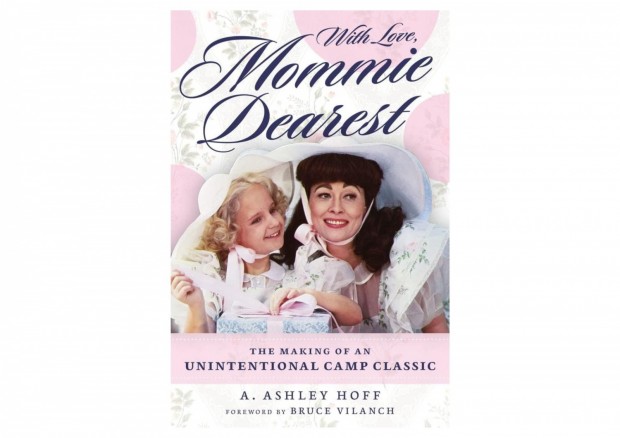New Book Details the Making of a Memorable Scene in 'Mommie Dearest' and Its Impact on Hollywood History

The new book "With Love, Mommie Dearest: The Making of an Unintentional Camp Classic" explores the journey of the film adaptation of Christine Crawford's memoir and its impact on Hollywood history. (Photo : Amazon/A. Hoff andBruce Vilanch)
Joan Crawford, an icon of Hollywood's Golden Age, is loved by many. However, her daughter Christine published a memoir in 1978, revealing a dark reality of child abuse.
The groundbreaking book brought attention to the problem, depicting their house as a battlefield between Joan, who was controlling and struggled with alcohol, and Christine, who was strong and survived despite the challenges. Christine's bravery in telling her story helped others who suffered from childhood abuse.
The movie adaptation with Faye Dunaway disappointed many when it came out in 1981. It did not capture the heart of the book and was criticized for making the Crawford family's life look too extreme. Despite initial setbacks, the movie eventually found success as a cult classic.
In the new book "With Love, Mommie Dearest: The Making of an Unintentional Camp Classic," author and Hollywood historian A. Ashley Hoff explores the film's journey to cult status. Delving into its release and enduring popularity, Hoff examines the underlying themes and issues it addresses.
Unveiling the Making of an Iconic Scene
In film, some scenes go down in history because of their power to evoke emotions and tell a story. One scene that exemplifies this is the wire hanger scene from the movie "Mommie Dearest," which is particularly significant in the history of cinema.
In the scene, Dunaway holds a wire hanger while delivering a sentence full of passion and emotion. The lines, which were written on the spot during filming, contain subtle hints about Joan's personal history and potential abuse.
Audiences might not realize the intricate process involved in bringing this scene to fruition. Actress Mara Hobel, who portrayed the young Christina, shared insights into the inner workings of filming the wire hanger scene. She explained the efforts made by the props team to create a hanger that would convey the desired effect without causing harm.
Despite the intensity of the scene, Hobel recalled moments of fun on set, such as when the first hanger bent and curved around her back, prompting laughter from the cast and crew. Eventually, a standard hanger was chosen, and Hobel was carefully layered to ensure her safety during filming.
Interestingly, Hobel's experience contrasts with that of Dunaway, who struggled to embody the character's rage and aggression fully. Director Frank Perry resorted to using a dummy in some shots. Dunaway's stand-in delivered the physical blows while Hobel cried off-screen.
This behind-the-scenes glimpse shows how hard it is to make a memorable movie scene. Despite challenges, the wire hanger scene is still a big part of film history. It shows how skilled and dedicated everyone involved was.
A Complex and Abusive Relationship
The relationship between Joan and Christina was complex and fraught with tension. Christina describes her childhood as extremely regimented and abusive in her memoir. She recounts endless chores, frequent beatings with hairbrushes, and the fear of being locked in a closet by her mother.
The household revolved around Joan's demanding behavior, with the children forced to play silently to avoid disturbing her. Joan's punishments were cruel and psychologically damaging, such as forcing Christina to wear a shredded dress for a week as punishment for damaging wallpaper. Christina recalls terrifying 'night raids,' where Joan would violently destroy her belongings and physically abuse her, including one incident where she was beaten with a can of Bon Ami for not cleaning properly.
These experiences left lasting emotional scars on Christina, who felt trapped in a cycle of misery and punishment.
RELATED ARTICLE: 'Sopranos' Actress Drea de Matteo Criticizes New Book Exposing James Gandolfini's Struggles
© 2023 Books & Review All rights reserved.
Popular Now
1
Books to Read After 'Fourth Wing': Top Picks for Fantasy and Romantasy Fans

2
‘The Secret Public’ by Jon Savage Book Review: An Insightful Look Into the LGBTQ Influence

3
Stephanie Regalado's 'If They Only Knew' Column Is Now A Book, Unleashing 60 Anonymous True Stories to Empower Women

4
'No Wire Hangers' Scene That Almost Did Not Happen: New Book Reveals Faye Dunaway's Struggles

5
Rare First Edition of Aphra Behn's Novel 'Oroonoko' Discovered in Kent: A Historic Literary Find

Latest Stories
Book Reviews
‘The Secret Public’ by Jon Savage Book Review: An Insightful Look Into the LGBTQ Influence

Book News
Stephanie Regalado's 'If They Only Knew' Column Is Now A Book, Unleashing 60 Anonymous True Stories to Empower Women

Book News
'No Wire Hangers' Scene That Almost Did Not Happen: New Book Reveals Faye Dunaway's Struggles

Book Reviews
‘The Perfect Couple’ by Elin Hilderbrand Book Review: A Captivating Summer Mystery

Book News
New Book ‘The Franchise’ Reveals Penguins President Kyle Dubas’ ‘Biggest Mistake’ as Maple Leafs GM











